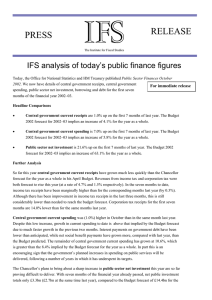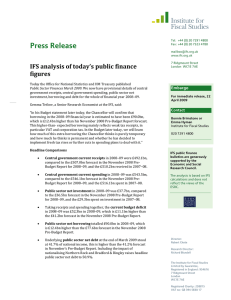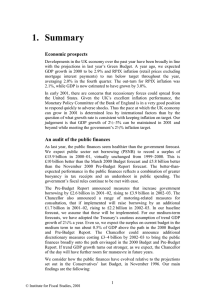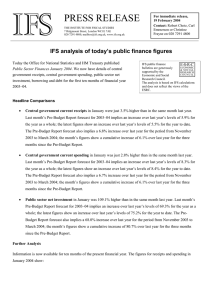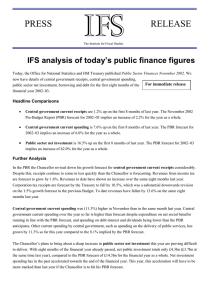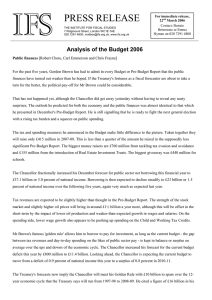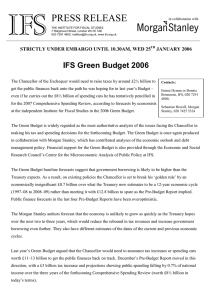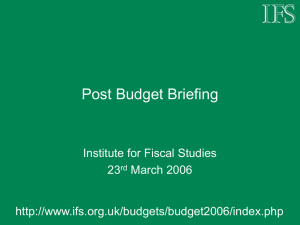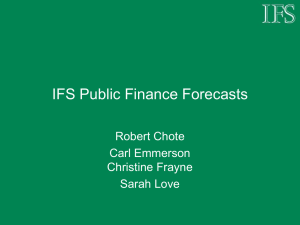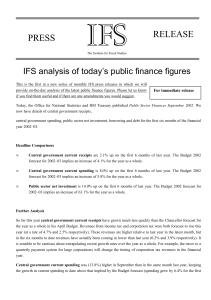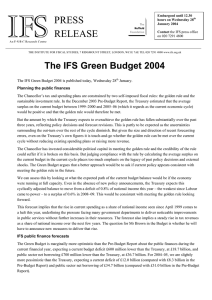IFS PRESS RELEASE
advertisement
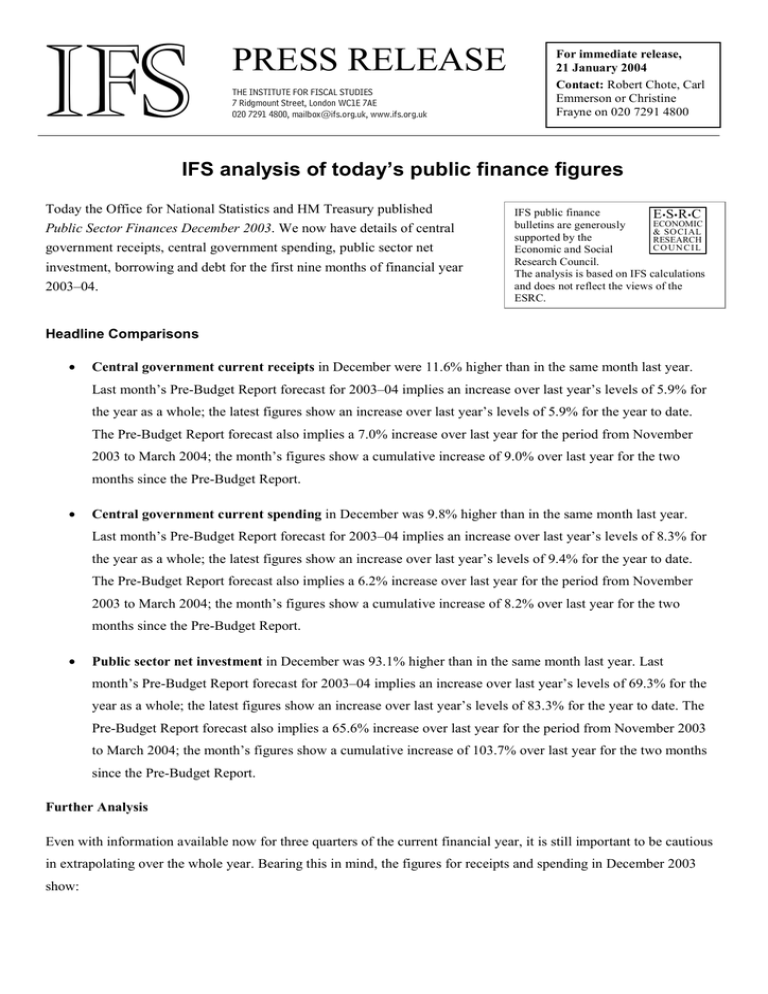
IFS PRESS RELEASE THE INSTITUTE FOR FISCAL STUDIES 7 Ridgmount Street, London WC1E 7AE 020 7291 4800, mailbox@ifs.org.uk, www.ifs.org.uk For immediate release, 21 January 2004 Contact: Robert Chote, Carl Emmerson or Christine Frayne on 020 7291 4800 IFS analysis of today’s public finance figures Today the Office for National Statistics and HM Treasury published Public Sector Finances December 2003. We now have details of central government receipts, central government spending, public sector net investment, borrowing and debt for the first nine months of financial year 2003–04. IFS public finance E •S• R• C ECONOMIC bulletins are generously & SOCIAL supported by the RESEARCH C O UN C I L Economic and Social Research Council. The analysis is based on IFS calculations and does not reflect the views of the ESRC. Headline Comparisons • Central government current receipts in December were 11.6% higher than in the same month last year. Last month’s Pre-Budget Report forecast for 2003–04 implies an increase over last year’s levels of 5.9% for the year as a whole; the latest figures show an increase over last year’s levels of 5.9% for the year to date. The Pre-Budget Report forecast also implies a 7.0% increase over last year for the period from November 2003 to March 2004; the month’s figures show a cumulative increase of 9.0% over last year for the two months since the Pre-Budget Report. • Central government current spending in December was 9.8% higher than in the same month last year. Last month’s Pre-Budget Report forecast for 2003–04 implies an increase over last year’s levels of 8.3% for the year as a whole; the latest figures show an increase over last year’s levels of 9.4% for the year to date. The Pre-Budget Report forecast also implies a 6.2% increase over last year for the period from November 2003 to March 2004; the month’s figures show a cumulative increase of 8.2% over last year for the two months since the Pre-Budget Report. • Public sector net investment in December was 93.1% higher than in the same month last year. Last month’s Pre-Budget Report forecast for 2003–04 implies an increase over last year’s levels of 69.3% for the year as a whole; the latest figures show an increase over last year’s levels of 83.3% for the year to date. The Pre-Budget Report forecast also implies a 65.6% increase over last year for the period from November 2003 to March 2004; the month’s figures show a cumulative increase of 103.7% over last year for the two months since the Pre-Budget Report. Further Analysis Even with information available now for three quarters of the current financial year, it is still important to be cautious in extrapolating over the whole year. Bearing this in mind, the figures for receipts and spending in December 2003 show: Central government current receipts Income and Capital Gains tax receipts in December 2003 were 3.3% higher than in the same month of last year. Last month’s Pre-Budget Report implies that these receipts would be 4.1% higher than last year for the whole year. Figures from the nine months to date show that these receipts have been 4.1% higher than over the same period last year. The Pre-Budget Report forecast also implies an increase of 4.4% over last year’s levels over the period from November 2003 to March 2004. The two months’ figures received since the Pre-Budget Report show a cumulative increase of 4.5% over the same months last year, indicating that Income and Capital Gains tax receipts are running in line with the Pre-Budget Report forecasts. VAT receipts in December 2003 were 19.1% higher than the same month last year. Last month’s Pre-Budget Report implies that VAT receipts would be 8.7% higher than last year for the whole year. Figures from the nine months to date show that these receipts have been 8.8% higher than over the same period last year. The Pre-Budget Report forecast also implies an increase of 9.7% over last year’s levels over the period from November 2003 to March 2004. The two months’ figures received since the Pre-Budget Report show a cumulative increase of 10.9% over the same months last year, indicating that VAT is coming in slightly above the Pre-Budget Report forecasts. In December 2003 there was growth of just 10.9% in cash receipts of social security contributions. By contrast, growth in accrued social security contributions was 27.7%. The discrepancy between the cash and accrued figures is because payments are taking longer to be recorded than they were last year. Last month’s Pre-Budget Report implies that cash social security receipts would be 12.2% higher than last year for the whole year. Figures from the nine months to date show that these receipts have been 9.6% and 17.9% higher than over the same period last year for cash and accruals measures respectively. The Pre-Budget Report forecast also implies a cash increase of 16.3% over last year’s levels over the period from November 2003 to March 2004. The two months’ figures received since the Pre-Budget Report show a cumulative increase of 11.6% and 21.9% over the same months last year. Growth in contributions on a cash basis are coming in below the Pre-Budget Report forecasts, but the faster growth in the accruals measure means that growth in the cash estimate should catch up over the remainder of the year. Central government current spending Expenditure on net social benefits was 1.4% higher in December 2003 compared to the same month last year. This is a moderate increase considering the additional expenditure incurred this year due to expenditure on the Pension Credit, which was introduced on October 6th 2003. The Pre-Budget Report forecast that central government net social benefit expenditure would be 7.0% higher than last year for the year as a whole. Over the first nine months of this current financial year, expenditure on net social benefits has been 7.2% higher than over the same period last year. The Pre-Budget Report forecasts also imply an increase of 6.2% on last year’s levels over the period from November 2003 to March 2004. Figures from the months since the Pre-Budget Report indicate a cumulative increase of 5.7% over November and December last year, indicating that spending on net social benefits is running slightly below the Pre-Budget Report forecasts. Spending on debt interest (which is relatively small as a share of spending overall) was lower in December 2003 than in December 2002. Other current spending by central government, including spending on the delivery of public services, was 15.6% higher in December 2003 than in December 2002. The Pre-Budget Report forecast this component of spending would be 8.9% higher than last year for the year as a whole. Over the first nine months of this current financial year, this spending has been 10.6% higher than over the same period last year. The Pre-Budget Report forecasts also imply an increase of 6.8% on last year’s levels over the period from November 2003 to March 2004. Figures from the months since the Pre-Budget Report indicate a cumulative increase of 10.8% over November and December last year, indicating that most departmental spending is running higher than implied in the Pre-Budget Report. In December 2003, public sector net investment was £1.3bn compared to £0.7bn in the same month in 2002. Cumulatively, in the first nine months of this financial year £8.9bn of public sector net investment has been undertaken, compared with £4.9bn in the same nine months last year. The Pre-Budget Report is forecasting investment spending of £18.0bn for the year as whole. Christine Frayne, a senior research economist at the IFS said: “Central government revenues were relatively strong last month, largely due to VAT receipts coming in well up on a year ago. But central government spending has grown strongly as well. The net effect is that the Chancellor’s forecasts in the Pre-Budget Report for public sector net borrowing and the current budget deficit this year both still look reasonable. However, the Chancellor’s forecasts for tax revenue in the medium term may be overoptimistic and to meet his fiscal rules with the comfort he has sought in the past he may need to announce new tax increases or reduce the tentative spending plans he pencilled into the Pre-Budget Report. We will estimate the size of any gap in our Green Budget next week. In the meantime, it is worth remembering that the Pre-Budget Report plans already assume significantly slower growth in spending on areas other than the NHS over the next four years than we have seen over the period since April 1999.” The IFS will be publishing a more in-depth analysis of the public finances and issues facing the Chancellor in the forthcoming Budget in its annual Green Budget on the 28th of January 2004. For more details please see http://www.ifs.org.uk/conferences/gb2004.shtml or email mailbox@ifs.org.uk Further information and contacts For further information on today’s public finance release please contact: Robert Chote, Carl Emmerson or Christine Frayne on 020 7291 4800, or email rchote@ifs.org.uk or cemmerson@ifs.org.uk or cfrayne@ifs.org.uk . Relevant links: This, and previous editions of this press release, can be downloaded from http://www.ifs.org.uk/press/pub_fin.shtml Useful links and background information on the Pre-Budget Report can be found at http://www.ifs.org.uk/budgetindex.shtml Office for National Statistics & HM Treasury, Public Sector Finances, December 2003: http://www.statistics.gov.uk/pdfdir/psf0104.pdf HM Treasury, Budget 2003: http://www.hm-treasury.gov.uk/budget/bud_bud03/bud_bud03_index.cfm HM Treasury, Pre-Budget Report 2003 is available at: http://www.hm-treasury.gov.uk/pre_budget_report/prebud_pbr03/prebud_pbr03_index.cfm HM Treasury, Public Finance Statistics Index: http://www.hm-treasury.gov.uk/economic_data_and_tools/pubfinance/data_pubfinance_index.cfm ENDS Notes to editors: 1. Central government current spending includes depreciation. 2. Where possible we compare figures on an accruals basis with the HM Treasury forecast.
